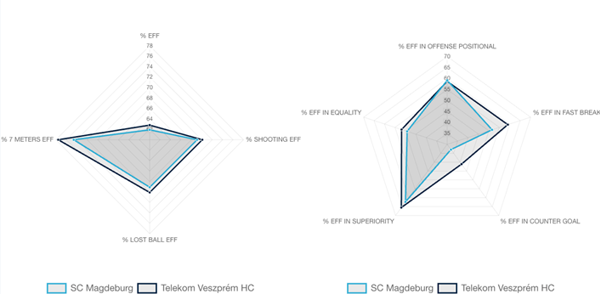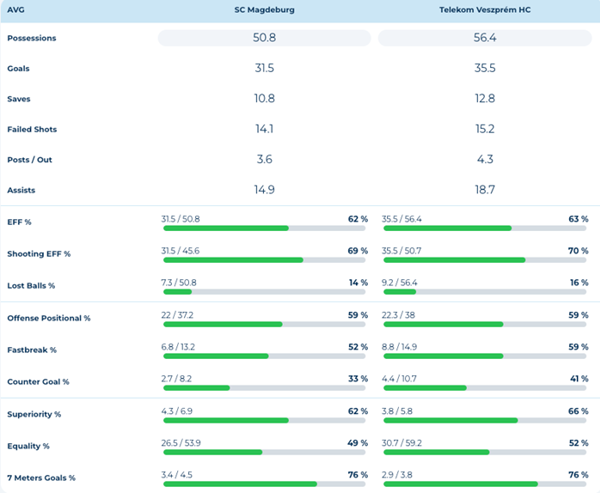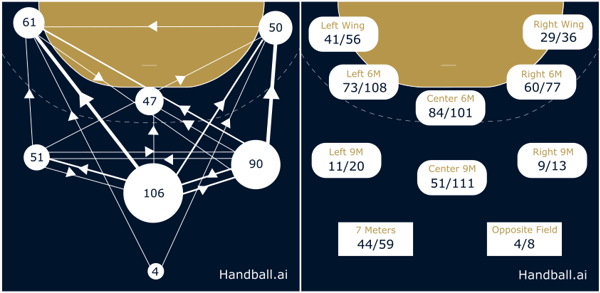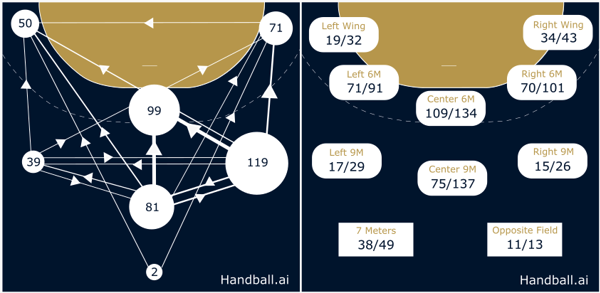As the showdown between Veszprém and Magdeburg is just around the corner, a comprehensive examination of their performances reveals intriguing insights into their respective strengths and weaknesses.
Let's go deeper into the statistics, incorporating the additional information provided, to paint a clearer picture of these handball giants.
Goal-scoring prowess
Showcasing their attacking prowess, Veszprém lead the EHF Champions League in goal scoring. They excel in fast breaks and counter-attack goals, ranking second in both categories. With 114 goals from fast breaks and 57 from counter attacks, they pose a formidable challenge to any defence. Highlighted by a 59 per cent and 41 per cent conversion rate, respectively, their ability to capitalise on transitional play and exploit defensive vulnerabilities are clear strengths.
Magdeburg, though not as prolific as Veszprém, still rank sixth in total goals. They shine in fast-break situations, sitting fourth overall. This shows their ability to exploit defensive weaknesses and create scoring chances from quick transitions. Magdeburg's disciplined approach to positional attack is reflected in their 60 per cent efficiency in offensive positional possessions. Their ability to maintain control and dictate the tempo of the game could prove instrumental in breaking down Veszprém’s defence.

Goalkeeper performance
At Magdeburg, Sergey Hernández and Nikola Portner share the goalkeeping duties. Hernández has a 25.5 per cent save rate, while Portner's is slightly higher at 31.6 per cent. Together, they provide a solid duo for Magdeburg, protecting their team in defence.
Veszprém recently acquired Mike Jensen, a former Magdeburg goalkeeper who has a remarkable 39 per cent save rate, significantly strengthening their defence. Paired with Rodrigo Corrales, who maintains a solid 28 per cent save rate, Veszprém’s goalkeepers form a strong last line of defence, ready to stop any opponent's attempts. Special attention should be given to the performance of Jensen, since he will be facing his former teammates.
Table with averages from the games played until round 13:

Tactical considerations
On the visuals:
- circle: indicates number of goals from players on this position; the higher the number, the bigger the circle
- lines beteen circles: indicates connections based on assists; the thicker the line, the higher the number of assists between those positions
- visual on the right: goals/shots or each position on court

The burning question for the coaching team at Veszprém is whether they can contain the formidable one-against-one power of Magdeburg. With three of the world's best one-against-one players all coming from the same national team, Magdeburg present a difficult challenge.
Analysing the connections and goals makes it evident that the danger primarily emanates from the right back (RB) and centre back (CB) positions, where standout players like Ómar Ingi Magnússon, Janus Smárason, Gísli Kristjánsson, and Felix Claar operate. Kristjánsson, after an operation, is coming back into Bennet Wiegert’s strategy.
Interestingly, despite not posing a significant threat from nine-metre shots or from the middle with a 46 per cent efficiency rate, Magdeburg excel in creating and exploiting one-against-one situations between positions one/two and five/six on the court.
These situations result in over 70 and 78 per cent success rates, respectively, indicating a clear strategy of generating opportunities in the middle to finish in the external zones, or direct attacking in one-against-one situations from the second defence position players.
Furthermore, in the centre of the six-metre area, Magdeburg demonstrate an exceptional efficiency rate of over 85 per cent – even if they have scored just 69 goals – highlighting their proficiency in one-against-one scenarios, often in tandem with attacks involving the line player.
In summary, Veszprém's ability to neutralise Magdeburg's lethal one-against-one capabilities will be critical in determining the outcome of the match.

Veszprém, driven by their passionate fans and led by head coach Momir Ilic, have set their sights beyond just reaching the TruckScout24 EHF FINAL4: they aim to win the EHF Champions League title. With a new goalkeeper in their ranks, they boast a star-studded line-up, particularly strong in the right back (RB) and centre back (CB) positions.
Players like Omar Yahia, Lukas Sandell, Nedim Remili, Agustíin Casado, Yehia Elderaa, and Kentin Mahé pose significant threats in attack. Additionally, the presence of Dragan Pechmalbec and Ludovic Fabregas adds to their offensive arsenal, making it challenging for defences to contain both playmakers and line players.
Examining their execution positions, Veszprém's attack leans heavily towards the centre six-metre area, with 109 goals scored (compared to the 69 of SC Magdeburg) from there, despite a similar efficiency to Magdeburg at 82 per cent. Notably, there is a limited contribution from the left wing, with only 19 goals originating from that position.
However, they excel in one/two and five/six situations, indicating a tactical preference for finishing in those areas rather than relying on the left wing. Indeed, the most frequent or dangerous place to finish seems to be between the one/two position with more than 78 per cent efficiency.
Compared to Magdeburg, Veszprém show similar parametres in nine-metre situations, except for the centre nine-metre, where they demonstrate a higher frequency of shots.
Conclusion
The last MOTW promises to become a showdown of epic proportions tonight (Thursday 7 March, 18:45 CET, live on EHFTV). We anticipate a thrilling handball match, while Veszprém might have a slight advantage due to the fact that they play at home, with a higher pace and higher efficiency in fast-break and counter-attack goals. Magdeburg’s never-say-die attitude and smart tactics could turn the tables. Don’t forget the power of the one-against-one situations approaching the external positions directly or creating superiority situations at the centre of the opponent’s defence.
Data provided by handball.ai and analysed by Manel Cirac, handball.ai and handball coach in women's second national division (2. Bundesliga)
Photo © 2023 Eroll Popova / Erpopress






